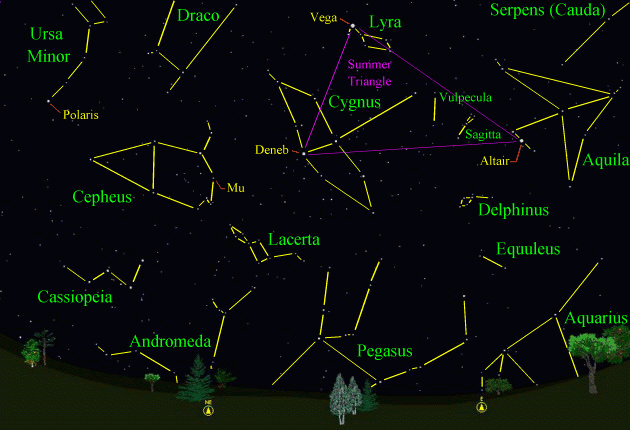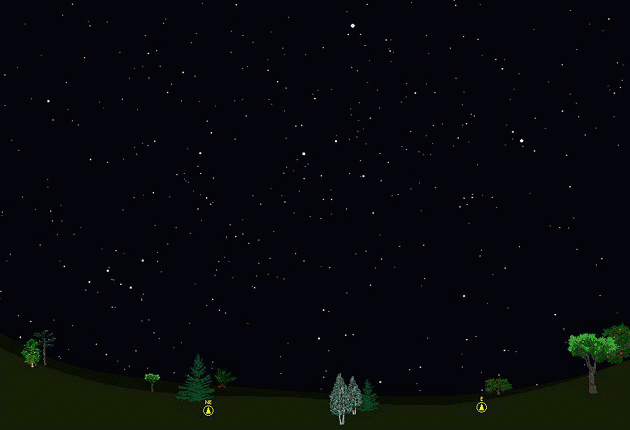The purpose of this feature is to give scout leaders, educators and naturalists an idea of some of the natural events coming up each month. We will try to cover a variety of natural events ranging from sky events to calling periods of amphibians, bird and mammal watching tips, prominent wildflowers and anything else that comes to mind. We will also note prominent constellations appearing over the eastern horizon at mid-evening each month for our area for those who would like to learn the constellations. If you have suggestions for other types of natural information you would like to see added to this calendar, let us know! Note: You can click on the hyperlinks to learn more about some of the featured items. To return to the Calendar, hit the "back" button on your browser, NOT the "back" button on the web page. All charts are available in a "printer friendly" mode, with black stars on a white background. Left clicking on each chart will take you to a printable black and white image.
Notes and Another Image From May 2008
Messier 100 uncoils its graceful spiral arms in the constellation of Coma Berenices. Discovered on March 15th, 1781 by Pierre Mechain, it was seen by Messier in April of the same year and included in his catalog. It is one of the brighter galaxies in the Virgo Cluster of galaxies. Measurements of Cephid variables in its spiral arms indicate a distance of 52 million light-years. This image was taken on May 4th. Four fainter galaxies can be seen above Messier 100 in the image, and three fainter galaxies can be seen below. The very bright core of Messier 100 can be made out in small telescopes, but it takes larger scopes to see the faint spiral arms. Messier said of object numbers 98, 99, and 100 in his catalog, “very difficult to recognize because of their feeble light; one can observe them only in good weather and near meridian passage.” For owners of small telescopes, this still holds true today. Sky Events for July 2008: Earth is at aphelion, its farthest point from the sun during the year, on July 4th. This is also the farthest the earth will be from the sun for this decade. Evening Sky: Mars and Saturn join the bright star Regulus to form a bright trio in the western sky after sunset. The Greek word for planet means "wanderer." The next few weeks present a great opportunity to see these two planets wander in relation to Regulus and to each other. You can see the changes in position from one day to the next. Look for the trio about 25 degrees above the western horizon about an hour after sunset. On July 1st, Mars is just above Regulus and the two are about a degree (about the width of your little finger at arm's length) apart. Saturn is less than 5 degrees above them and to the left. Compare the light of Mars and Saturn to Regulus. Planets, because they are not true points of light, usually do not "twinkle" as much as stars do. Watch for Mars and Saturn to approach each other to less than a degree on July 10th. Jupiter rises at dusk at the beginning of the month in Sagittarius. This is a good time to get out and observe the giant planet and its moons. Morning Sky: Mercury reaches greatest elongation from the sun on July 1st. Look for it just over the east-northeast horizon about 45 minutes before sunrise. It should be visible for the first two weeks in July. All times noted in the Sky Events are for Franklin, Tennessee and are Central Daylight Time. These times should be pretty close anywhere in the mid-state area. Constellations: The views below show the sky looking east at 10:10pm CDT on July 10th. The first view shows the sky with the constellation outlined and names depicted. Star and planet names are in yellow. Constellation names are in green. The second view shows the same scene without labels. New constellations this month in the eastern sky are Cygnus, the Swan, with its bright star Deneb, and Aquila, the Eagle, with its bright star Altair. The bright stars Deneb, Altair and Vega form the "Summer Triangle." If you locate them first, you will have an easier time finding the constellations around them. Below and to the left of Altair is the constellation of Delphinus, the Dolphin, looking like it's leaping over the eastern horizon. Above Delphinus look for the arrow-like form of Sagitta, the Arrow. Between Sagitta and Cygnus lie the faint stars of Vulpecula, the Fox. Easier to spot are the brightest stars of Sagittarius, the Archer, which form a grouping nicknamed, "The Teapot." Look for them just above the southeast horizon. "The Teapot" will become easier to see as it rises higher above the horizon. On very clear summer nights the bright portions of the Milky Way above Sagittarius look like steam rising from the spout of the teapot. If you look just to the right of the spout of the teapot, you will be looking in the direction of the center of our galaxy. The little grouping of stars to the left of Sagittarius is nicknamed, "The Teaspoon." The bright planet Jupiter is just below the teaspoon this month. All of the constellation Scorpius, the Scorpion, with its bright star Antares, should now be above the horizon in the southeast. Also in the southeast and above Sagittarius, look for the faint stars of Scutum.
On Learning the Constellations: We advise learning a few constellations each month, and then following them through the seasons. Once you associate a particular constellation coming over the eastern horizon at a certain time of year, you may start thinking about it like an old friend, looking forward to its arrival each season. The stars in the evening scene above, for instance, will always be in the same place relative to the horizon at the same time and date each July. Of course, the planets do move slowly through the constellations, but with practice you will learn to identify them from their appearance. In particular, learn the brightest stars (like Altair and Vega in the above scene looking northeast), for they will guide you to the fainter stars. Once you can locate the more prominent constellations, you can "branch out" to other constellations around them. It may take you a little while to get a sense of scale, to translate what you see on the computer screen or what you see on the page of a book to what you see in the sky. Look for patterns, like the stars that make up the constellation Lyra. The earth's rotation causes the constellations to appear to move across the sky just as the sun and the moon appear to do. If you go outside earlier than the time shown on the charts, the constellations will be lower to the eastern horizon. If you observe later, they will have climbed higher. As each season progresses, the earth's motion around the sun causes the constellations to appear a little farther towards the west each night for any given time of night. If you want to see where the constellations in the above figures will be on August 15th at 10:10pm CDT, you can stay up till 12:10pm CDT on July 15th and get a preview. The westward motion of the constellations is equivalent to two hours per month. Sky Publishing has just come out with a beautiful and compact star atlas, Sky & Telescope's Pocket Star Atlas. It is destined to become a classic, and is a joy to use at the telescope. A good book to learn the constellations is Patterns in the Sky, by Hewitt-White. You may also want to check out at H. A. Rey's classic, The Stars, A New Way to See Them. Another good book, at $34.95 a little more expensive but with many great features, is A Constellation Album, by P. K. Chen. It has beautiful photos of the night sky with clear overlays that show the traditional constellation outlines. For skywatching tips, an inexpensive good guide is Secrets of Stargazing, by Becky Ramotowski. A good general reference book on astronomy is the Peterson
Field Guide,
A Field Guide to the Stars and Planets, by Pasachoff.
The book retails for around $14.00. Starry Night has several software programs for learning the night sky. Visit the Starry Night web site at www.starrynight.com for details.
Amphibians:
July’s frogs and toads are much like June’s. Listen for Cope's Gray Treefrogs, Gray Treefrogs, Bird-Voiced Treefrogs, Green Treefrogs and Barking Treefrogs. Northern Cricket Frogs and Southern Cricket Frogs call a lot during July, and the calls of Bullfrogs and Green Frogs fill the night air. After heavy rains listen for the high, insect-like call of the Eastern Narrowmouth Toad and the strange-sounding Eastern Spadefoot. Be sure to look closely at young toads you encounter. Sometimes we find young Eastern Spadefoots foraging during the day. A young Eastern Spadefoot will have vertical pupils, a tiny spade on its rear feet and will often have some red warts, even when only a fraction of an inch long. A hand lens helps to see these features (or turn your binoculars around and use them for a magnifying glass.)
Birds: Now is a good time to get to know the breeding birds of Tennessee. It's fun to take a trip to the Great Smoky Mountains National Park in June and hike a high altitude trail, like the Alum Cave Bluff trail. By doing so you can encounter birds that breed in Tennessee at these higher elevations, like Black-throated Blue Warblers, Canada Warblers, Chestnut-sided Warblers and Blackburnian Warblers. Recommended: Bird Finding in Tennessee, Michael Lee Bierly. A classic guide to finding birds in Tennessee. The Sibley Guide to Birds, David Allen Sibley The Sibley Guide to Birds of Eastern North America, David Allen Sibley An inexpensive guide for beginners is the Golden Guide for Birds.
Archives (Remember to use the back button on your browser, NOT the back button on the web page!)
Natural Calendar February 2008 Natural Calendar December 2007 Natural Calendar November 2007 Natural Calendar September 2007 Natural Calendar February 2007 Natural Calendar December 2006 Natural Calendar November 2006 Natural Calendar September 2006 Natural Calendar February 2006
Natural Calendar
December 2005
Natural Calendar
November 2005
Natural Calendar
September 2005
Natural Calendar
February 2005
Natural Calendar
December 2004
Natural Calendar
November 2004
Natural Calendar
September 2004
Natural Calendar
February 2004
Natural Calendar
December 2003
Natural Calendar
November 2003
Natural Calendar
September 2003 Natural Calendar February 2003 Natural Calendar December 2002 Natural Calendar November 2002 Nature Notes Archives: Nature Notes was a page we published in 2001 and 2002 containing our observations about everything from the northern lights display of November 2001 to frog and salamander egg masses. Night scenes prepared with Starry Night Pro software All images and recordings © 2008 Leaps
|





